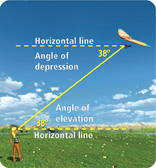8-4 Angles of Elevation and Depression
Objective
To use angles of elevation and depression to solve problems
 Lesson Vocabulary
Lesson Vocabulary
- angle of elevation
- angle of depression
The angles in the Solve It are formed below the horizontal black pipe. Angles formed above and below a horizontal line have specific names.
Suppose a person on the ground sees a hang glider at a
At the same time, a person in the hang glider sees the person on the ground at a

Notice that the angle of elevation is congruent to the angle of depression because they are alternate interior angles.
Essential Understanding You can use the angles of elevation and depression as the acute angles of right triangles formed by a horizontal distance and a vertical height.
Table of Contents
- 6-1 The Polygon Angle-Sum Theorems
- 6-2 Properties of Parallelograms
- 6-3 Proving That a Quadrilateral Is a Parallelogram
- 6-4 Properties of Rhombuses, Rectangles, and Squares
- 6-5 Conditions for Rhombuses, Rectangles, and Squares
- 6-6 Trapezoids and Kites
- 6-7 Polygons in the Coordinate Plane
- 6-8 and 6-9 Coordinate Geometry and Coordinate Proofs





